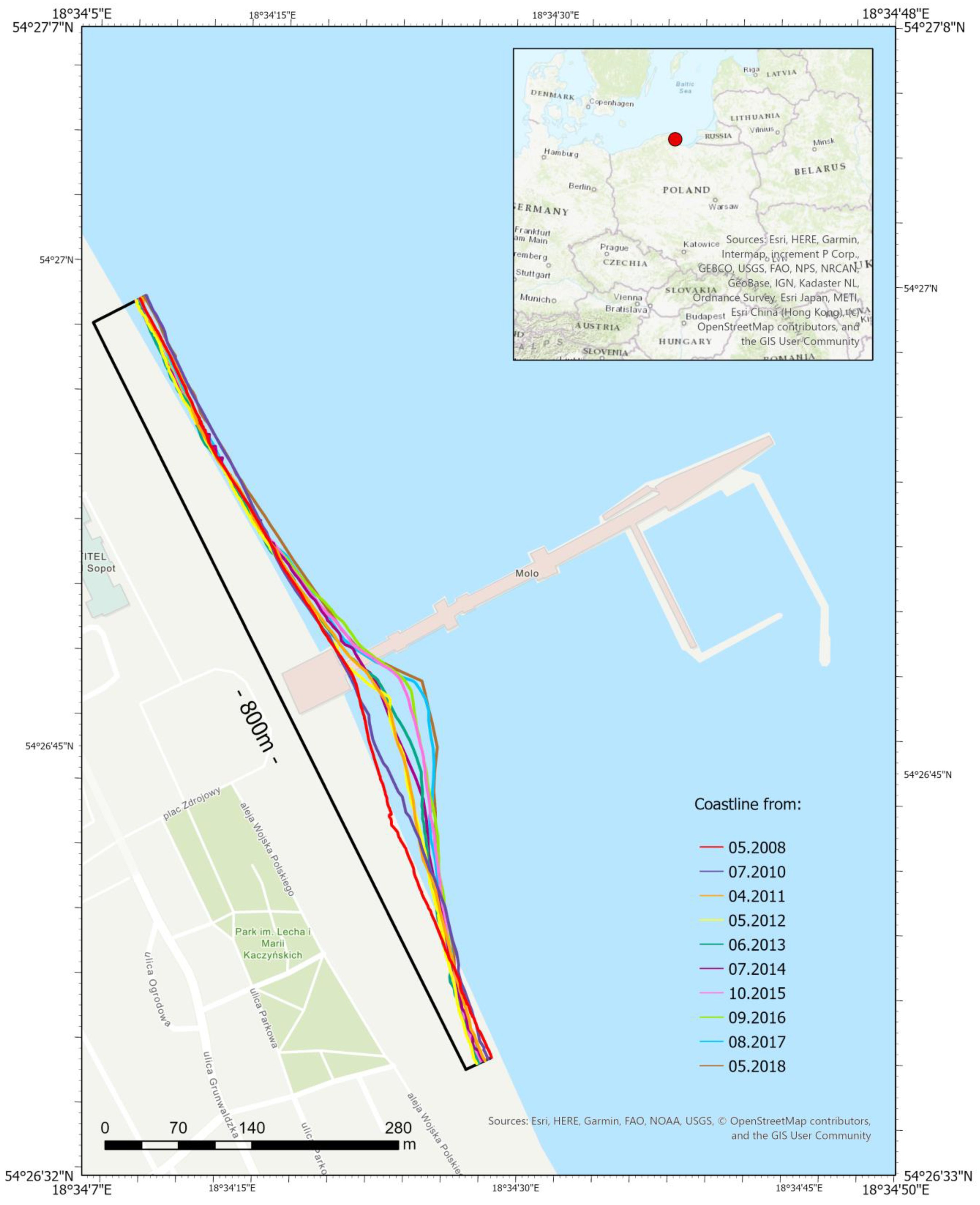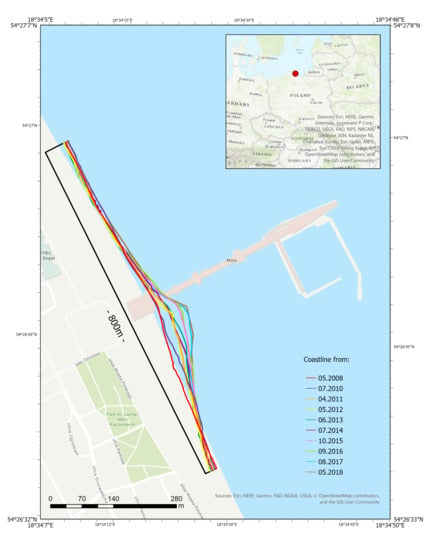Study on the Coastline Evolution in Sopot (2008–2018) Based on Landsat Satellite Imagery
Abstract
:1. Introduction
2. Materials and Methods—Vectorization of Satellite Images Taking into Account Hydrological Data
3. Results
3.1. Analysis of Beach Surface Changes in Sopot
3.2. Analysis of Coastline Variability in Sopot
4. Discussion
Author Contributions
Funding
Conflicts of Interest
References
- Li, Z.; Zhai, J.; Wu, F. Shape similarity assessment method for coastline generalization. ISPRS Int. J. Geo-Inf. 2018, 7, 283. [Google Scholar] [CrossRef] [Green Version]
- Sui, L.; Wang, J.; Yang, X.; Wang, Z. Spatial-temporal characteristics of coastline changes in Indonesia from 1990 to 2018. Sustainability 2020, 12, 3242. [Google Scholar] [CrossRef] [Green Version]
- Li, J.; Ye, M.; Pu, R.; Liu, Y.; Guo, Q.; Feng, B.; Huang, R.; He, G. Spatiotemporal change patterns of coastlines in Zhejiang Province, China, over the last twenty-five years. Sustainability 2018, 10, 477. [Google Scholar] [CrossRef] [Green Version]
- Chu, Z.X.; Yang, X.H.; Feng, X.L.; Fan, D.J.; Li, Y.K.; Shen, X.; Miao, A.Y. Temporal and spatial changes in coastline movement of the Yangtze Delta during 1974–2010. J. Asian Earth Sci. 2013, 66, 166–174. [Google Scholar] [CrossRef]
- Cowart, L.; Corbett, D.R.; Walsh, J.P. Shoreline change along sheltered coastlines: Insights from the Neuse River Estuary, NC, USA. Remote Sens. 2011, 3, 1516–1534. [Google Scholar] [CrossRef] [Green Version]
- Kuleli, T.; Guneroglu, A.; Karsli, F.; Dihkan, M. Automatic detection of shoreline change on coastal Ramsar wetlands of Turkey. Ocean Eng. 2011, 38, 1141–1149. [Google Scholar] [CrossRef]
- Martínez, C.; Quezada, M.; Rubio, P. Historical changes in the shoreline and littoral processes on a headland bay beach in central Chile. Geomorphology 2011, 135, 80–96. [Google Scholar] [CrossRef]
- Zhang, X.; Pan, D.; Chen, J.; Zhao, J.; Zhu, Q.; Huang, H. Evaluation of coastline changes under human intervention using multi-temporal high-resolution images: A case study of the Zhoushan Islands, China. Remote Sens. 2014, 6, 9930–9950. [Google Scholar] [CrossRef] [Green Version]
- Mury, A.; Jeanson, M.; Collin, A.; James, D.; Etienne, S. High resolution shoreline and shelly ridge monitoring over stormy winter events: A case study in the megatidal Bay of Mont-Saint-Michel (France). J. Mar. Sci. Eng. 2019, 7, 97. [Google Scholar] [CrossRef] [Green Version]
- Mahamud, U.; Takewaka, S. Shoreline change around a river delta on the Cox’s Bazar coast of Bangladesh. J. Mar. Sci. Eng. 2018, 6, 80. [Google Scholar] [CrossRef] [Green Version]
- Nikolakopoulos, K.; Kyriou, A.; Koukouvelas, I.; Zygouri, V.; Apostolopoulos, D. Combination of aerial, satellite, and UAV photogrammetry for mapping the diachronic coastline evolution: The case of Lefkada island. ISPRS Int. J. Geo-Inf. 2019, 8, 489. [Google Scholar] [CrossRef] [Green Version]
- Kanwal, S.; Ding, X.; Sajjad, M.; Abbas, S. Three decades of coastal changes in Sindh, Pakistan (1989–2018): A geospatial assessment. Remote Sens. 2020, 12, 8. [Google Scholar] [CrossRef] [Green Version]
- Zhang, Y.; Hou, X. Characteristics of coastline changes on Southeast Asia islands from 2000 to 2015. Remote Sens. 2020, 12, 519. [Google Scholar] [CrossRef] [Green Version]
- Fu, Y.; Guo, Q.; Wu, X.; Fang, H.; Pan, Y. Analysis and prediction of changes in coastline morphology in the Bohai Sea, China, using remote sensing. Sustainability 2017, 9, 900. [Google Scholar] [CrossRef] [Green Version]
- Martínez, C.; Contreras-López, M.; Winckler, P.; Hidalgo, H.; Godoy, E.; Agredano, R. Coastal erosion in central Chile: A new hazard? Ocean Coast. Manag. 2018, 156, 141–155. [Google Scholar] [CrossRef]
- Narra, P.; Coelho, C.; Sancho, F. Multicriteria GIS-based estimation of coastal erosion risk: Implementation to Aveiro Sandy Coast, Portugal. Ocean Coast. Manag. 2019, 178, 104845. [Google Scholar] [CrossRef]
- Bird, E.C.F. Coastline Changes: A Global Review; Wiley: Chichester, UK, 1985. [Google Scholar]
- Luijendijk, A.; Hagenaars, G.; Ranasinghe, R.; Baart, F.; Donchyts, G.; Aarninkhof, S. The state of the world’s beaches. Sci. Rep. 2018, 8, 6641. [Google Scholar] [CrossRef]
- National Institute of Coastal and Marine Management of The Netherlands. A Guide to Coastal Erosion Management Practices in Europe: Lessons Learned. Available online: http://www.eurosion.org/shoreline/lessons_learned.pdf (accessed on 5 June 2020).
- Bitan, M.; Zviely, D. Sand beach nourishment: Experience from the Mediterranean coast of Israel. J. Mar. Sci. Eng. 2020, 8, 273. [Google Scholar] [CrossRef] [Green Version]
- Angoni, H.; Tatchim, A.P.; Nkonmeneck, B.A.; Nguekam, E. Use of the wood in coastal fisheries zones of Cameroun. Rev. D’ethnoécol. 2015, 7, 1–14. [Google Scholar]
- Fossi Fotsi, Y.; Pouvreau, N.; Brenon, I.; Onguene, R.; Etame, J. Temporal (1948–2012) and dynamic evolution of the Wouri estuary coastline within the Gulf of Guinea. J. Mar. Sci. Eng. 2019, 7, 343. [Google Scholar] [CrossRef] [Green Version]
- Viaña-Borja, S.P.; Ortega-Sánchez, M. Automatic methodology to detect the coastline from Landsat images with a new water index assessed on three different Spanish Mediterranean deltas. Remote Sens. 2019, 11, 2186. [Google Scholar] [CrossRef] [Green Version]
- Dellepiane, S.; De Laurentiis, R.; Giordano, F. Coastline extraction from SAR images and a method for the evaluation of the coastline precision. Pattern Recognit. Lett. 2004, 25, 1461–1470. [Google Scholar] [CrossRef]
- Al-Mansoori, S.; Al-Marzouqi, F. Coastline extraction using satellite imagery and image processing techniques. Int. J. Curr. Eng. Technol. 2016, 6, 1245–1251. [Google Scholar]
- Wang, X.; Liu, Y.; Ling, F.; Liu, Y.; Fang, F. Spatio-temporal change detection of Ningbo coastline using Landsat time-series images during 1976–2015. ISPRS Int. J. Geo-Inf. 2017, 6, 68. [Google Scholar] [CrossRef] [Green Version]
- Maglione, P.; Parente, C.; Vallario, A. Coastline extraction using high resolution WorldView-2 satellite imagery. Eur. J. Remote Sens. 2014, 47, 685–699. [Google Scholar] [CrossRef]
- Xu, N. Detecting coastline change with all available Landsat data over 1986–2015: A case study for the State of Texas, USA. Atmosphere 2018, 9, 107. [Google Scholar] [CrossRef] [Green Version]
- Specht, C.; Weintrit, A.; Specht, M.; Dąbrowski, P. Determination of the territorial sea baseline—Measurement aspect. IOP Conf. Ser. Earth Environ. Sci. 2017, 95, 1–10. [Google Scholar] [CrossRef] [Green Version]
- Specht, M.; Specht, C.; Wąż, M.; Dąbrowski, P.; Skóra, M.; Marchel, Ł. Determining the variability of the territorial sea baseline on the example of waterbody adjacent to the municipal beach in Gdynia. Appl. Sci. 2019, 9, 3867. [Google Scholar] [CrossRef] [Green Version]
- Basterretxea, G.; Orfila, A.; Jordi, A.; Fornós, J.; Tintoré, J. Evaluation of a small volume renourishment strategy on a narrow Mediterranean beach. Geomorphology 2007, 88, 139–151. [Google Scholar] [CrossRef] [Green Version]
- Del Río, L.; Gracia, F.J.; Benavente, J. Shoreline change patterns in sandy coasts. A case study in SW Spain. Geomorphology 2013, 196, 252–266. [Google Scholar] [CrossRef] [Green Version]
- An, M.; Sun, Q.; Hu, J.; Tang, Y.; Zhu, Z. Coastline detection with Gaofen-3 SAR images using an improved FCM method. Sensors 2018, 18, 1898. [Google Scholar] [CrossRef] [Green Version]
- Prishchepov, A.V.; Radeloff, V.C.; Dubinin, M.; Alcantara, C. The effect of Landsat ETM/ETM + image acquisition dates on the detection of agricultural land abandonment in Eastern Europe. Remote Sens. Environ. 2012, 126, 195–209. [Google Scholar] [CrossRef]
- DeVries, B.; Verbesselt, J.; Kooistra, L.; Herold, M. Robust monitoring of small-scale forest disturbances in a tropical montane forest using Landsat time series. Remote Sens. Environ. 2015, 161, 107–121. [Google Scholar] [CrossRef]
- Yusuf, Y.; Matsuoka, M.; Yamazaki, F. Damage assessment after 2001 Gujarat earthquake using Landsat-7 satellite images. J. Indian Soc. Remote Sens. 2001, 29, 17–22. [Google Scholar] [CrossRef]
- Santillan, J.; Makinano, M.; Paringit, E. Integrated Landsat image analysis and hydrologic modeling to detect impacts of 25-year land-cover change on surface runoff in a Philippine watershed. Remote Sens. 2011, 3, 1067–1087. [Google Scholar] [CrossRef] [Green Version]
- Yuan, F.; Sawaya, K.E.; Loeffelholz, B.C.; Bauer, M.E. Land cover classification and change analysis of the Twin Cities (Minnesota) Metropolitan Area by multitemporal Landsat remote sensing. Remote Sens. Environ. 2005, 98, 317–328. [Google Scholar] [CrossRef]
- Rasuly, A.; Naghdifar, R.; Rasoli, M. Monitoring of Caspian Sea coastline changes using object-oriented techniques. Procedia Environ. Sci. 2010, 2, 416–426. [Google Scholar] [CrossRef] [Green Version]
- Rokni, K.; Ahmad, A.; Selamat, A.; Hazini, S. Water feature extraction and change detection using multitemporal landsat imagery. Remote Sens. 2014, 6, 4173–4189. [Google Scholar] [CrossRef] [Green Version]
- Zhang, T.; Yang, X.; Hu, S.; Su, F. Extraction of coastline in aquaculture coast from multispectral remote sensing images: Object-based region growing integrating edge detection. Remote Sens. 2013, 5, 4470–4487. [Google Scholar] [CrossRef] [Green Version]
- Almonacid-Caballer, J.; Sánchez-García, E.; Pardo-Pascual, J.E.; Balaguer-Beser, A.; Palomar-Vázquez, J. Evaluation of annual mean shoreline position deduced from Landsat imagery as a mid-term coastal evolution indicator. Mar. Geol. 2016, 372, 79–88. [Google Scholar] [CrossRef]
- Masnicki, R.; Specht, C.; Mindykowski, J.; Dąbrowski, P.; Specht, M. Accuracy analysis of measuring X-Y-Z coordinates with regard to the investigation of the tombolo effect. Sensors 2020, 20, 1167. [Google Scholar] [CrossRef] [Green Version]
- Specht, C.; Lewicka, O.; Specht, M.; Dąbrowski, P.; Burdziakowski, P. Methodology for carrying out measurements of the tombolo geomorphic landform using unmanned aerial and surface vehicles near Sopot pier, Poland. J. Mar. Sci. Eng. 2020, 8, 384. [Google Scholar] [CrossRef]
- Specht, C.; Mindykowski, J.; Dąbrowski, P.; Maśnicki, R.; Marchel, Ł.; Specht, M. Metrological aspects of the tombolo effect investigation—Polish case study. In Proceedings of the 2019 IMEKO TC-19 International Workshop on Metrology for the Sea (IMEKO 2019), Genova, Italy, 3–5 October 2019. [Google Scholar]
- Specht, M.; Specht, C.; Mindykowski, J.; Dąbrowski, P.; Maśnicki, R.; Makar, A. Geospatial modeling of the tombolo phenomenon in Sopot using integrated geodetic and hydrographic measurement methods. Remote Sens. 2020, 12, 737. [Google Scholar] [CrossRef] [Green Version]
- Urbański, J. GIS in Nature Study; University of Gdańsk Publishing House: Gdańsk, Poland, 2008. (In Polish) [Google Scholar]
- Council of Ministers of the Republic of Poland. Ordinance of the Council of Ministers of 15 October 2012 on the National Spatial Reference System; Council of Ministers of the Republic of Poland: Warsaw, Poland, 2012. (In Polish)
- Rokiciński, K. Geographical and hydrometeorogical characteristics of Baltic Sea as are for asymetric warfare. Sci. J. Polish Naval Acad. 2007, 1, 65–82. (In Polish) [Google Scholar]
- IMGW-PIB. Hydrological Data. Available online: https://dane.imgw.pl/datastore (accessed on 5 June 2020). (In Polish).
- Leatherman, S.P. Undertow, Rip Current, and Riptide. J. Coast. Res. 2012, 28, 3–5. [Google Scholar]
- Mujabar, S.; Chandrasekar, N. A shoreline change analysis along the coast between Kanyakumari and Tuticorin, India, using digital shoreline analysis system. Geo-Spat. Inf. Sci. 2011, 14, 282–293. [Google Scholar]
- Källstrand, B.; Bergström, H.; Højstrup, J.; Smedman, A.S. Mesoscale Wind Field Modifications over the Baltic Sea. Bound. Layer Meteorol. 2000, 95, 161–188. [Google Scholar] [CrossRef]
- Stigebrandt, A. Physical Oceanography of the Baltic Sea. In A Systems Analysis of the Baltic Sea, 1st ed.; Wulff, F.V., Rahm, L., Larsson, P., Eds.; Springer: Berlin/Heidelberg, Germany, 2001; pp. 19–74. [Google Scholar]
- Ostrowski, R.; Stella, M.; Szmytkiewicz, P.; Kapiński, J.; Marcinkowski, T. Coastal Hydrodynamics beyond the Surf Zone of the South Baltic Sea. Oceanologia 2018, 60, 264–276. [Google Scholar] [CrossRef]
- Sopot NaszeMiasto.pl. In Sopot, They Continue to Strengthen and Expand the Beach. Available online: https://sopot.naszemiasto.pl/w-sopocie-kontynuuja-umacnianie-i-poszerzanie-plazy-wideo/ar/c2-4318220 (accessed on 5 June 2020). (In Polish).
- Specht, M.; Specht, C.; Wąż, M.; Naus, K.; Grządziel, A.; Iwen, D. Methodology for performing territorial sea baseline measurements in selected waterbodies of Poland. Appl. Sci. 2019, 9, 3053. [Google Scholar] [CrossRef] [Green Version]
- Gross, M.G.; Gross, E. Oceanography: A View of the Earth, 7th ed.; Prentice Hall: Upper Saddle River, NJ, USA, 1995. [Google Scholar]
- World Meteorological Organization. Guide to Wave Analysis and Forecasting, 2nd ed.; WMO: Geneva, Switzerland, 1998. [Google Scholar]






| Month and Year | Number of Measurements | Minimum Value [cm] | Maximum Value [cm] | Mean Value [cm] | Median Value [cm] |
|---|---|---|---|---|---|
| 05.2008 | 8618 | 492.7 | 551.3 | 516.9 | 514.3 |
| 07.2010 | 4464 | 496.4 | 538.7 | 513.0 | 512.5 |
| 04.2011 | 8618 | 492.7 | 551.3 | 516.9 | 514.3 |
| 05.2012 | 4459 | 476.9 | 520.3 | 501.5 | 501.7 |
| 06.2013 | 4301 | 477.8 | 527.2 | 503.2 | 503.1 |
| 07.2014 | 4432 | 479.9 | 520.4 | 500.1 | 498.5 |
| 10.2015 | 4445 | 459.0 | 518.0 | 488.2 | 487.0 |
| 09.2016 | 4320 | 474.0 | 533.0 | 506.0 | 507.0 |
| 08.2017 | 4464 | 490.0 | 536.0 | 512.9 | 513.0 |
| 05.2018 | 4464 | 472.0 | 514.0 | 491.6 | 492.0 |
© 2020 by the authors. Licensee MDPI, Basel, Switzerland. This article is an open access article distributed under the terms and conditions of the Creative Commons Attribution (CC BY) license (http://creativecommons.org/licenses/by/4.0/).
Share and Cite
Specht, M.; Specht, C.; Lewicka, O.; Makar, A.; Burdziakowski, P.; Dąbrowski, P. Study on the Coastline Evolution in Sopot (2008–2018) Based on Landsat Satellite Imagery. J. Mar. Sci. Eng. 2020, 8, 464. https://doi.org/10.3390/jmse8060464
Specht M, Specht C, Lewicka O, Makar A, Burdziakowski P, Dąbrowski P. Study on the Coastline Evolution in Sopot (2008–2018) Based on Landsat Satellite Imagery. Journal of Marine Science and Engineering. 2020; 8(6):464. https://doi.org/10.3390/jmse8060464
Chicago/Turabian StyleSpecht, Mariusz, Cezary Specht, Oktawia Lewicka, Artur Makar, Paweł Burdziakowski, and Paweł Dąbrowski. 2020. "Study on the Coastline Evolution in Sopot (2008–2018) Based on Landsat Satellite Imagery" Journal of Marine Science and Engineering 8, no. 6: 464. https://doi.org/10.3390/jmse8060464
APA StyleSpecht, M., Specht, C., Lewicka, O., Makar, A., Burdziakowski, P., & Dąbrowski, P. (2020). Study on the Coastline Evolution in Sopot (2008–2018) Based on Landsat Satellite Imagery. Journal of Marine Science and Engineering, 8(6), 464. https://doi.org/10.3390/jmse8060464









